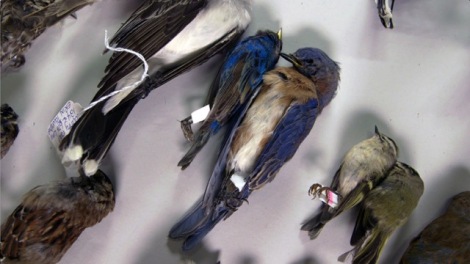This post comes from the Artists and Climate Change Blog
by Guest Blogger Su Rynard
There is more than one way to look at the world, and scientists, like artists begin with questions, and both practices push the boundaries of knowledge and perception. As a filmmaker and media artist, scientists have inhabited my work for some time. I’m drawn to their research as a departure point for artistic inquiry. I don’t have a scientific background so every new piece I create begins with an exploratory journey.
I live in Canada where we have just endured a decade of anti-scientific government policy. In fact scientists around the world are to varying degrees, constrained by belief and ideology from all sides. This is clearly the case with climate change, where denial often trumps evidence-based research.
I have wondered if this denial has something to do with a societal need for visual evidence. Icons if you will – the need to see to believe. Consider the discovery of nuclear fission. The truth of this power is best understood through the visceral images of the destruction it caused, not the abstraction of the science itself. The same could be said of humans landing on the moon. The event itself was televised and the photograph of the whole Earth from outer space became the most reproduced image in all of human history.
Today landscapes are being transformed by global warming, and the tragic effects are visible. We now have tangible evidence of damage that will continue to occur unless humanity collectively succeeds in mitigating the effects of climate change. In 2005, Bill McKibben wrote about that very famous picture of the Earth taken from the moon. “Already that’s not the world we inhabit; its poles are melting, its oceans rising. We can register what is happening with satellites and scientific instruments, but can we register it in our imaginations, the most sensitive of all our devices?â€
My hope is that by bridging the scientific and creative worlds artists can help bring climate to the forefront of cultural conversations. This was certainly a goal I had when I began my recent feature documentary film, The Messenger.
The Messenger is the artful story about the mass depletion of songbirds on multiple continents, revealing how the issues facing birds also pose daunting implications for our planet and ourselves. Filmed over two years on three continents, The Messenger is a moving and epic journey, as the film mixes its elegiac message with hopeful notes and unique glances into the influence of songbirds on our own expressions of the soul. Birds are winged sentinels, over time and across cultures, they have sent us signals about the health of our environment. Today once again, birds have something to tell us – and with this documentary, I wanted to amplify their message.
Today climate change poses a dire threat to birds worldwide, as thousands of species are highly vulnerable to global warming. In the words of Christy Morrissey, an eco-toxicologist featured in The Messenger, “We are changing the environment faster than birds can cope with. So we have to either stop what we’re doing and think about how to do it better, or pay the consequence of hearing total silenceâ€. The changes in their behaviour and decline in their numbers are a warning. If the planet cannot sustain life for them, it cannot sustain life for us. In this way, the uncertain fate of the songbird is inextricably linked to our own.
I’m pleased to have two short works Bear and Drowning London included in ikonoTV’s official ArtCop21 event Art Speaks Out. Art Speaks Out is an on-air exhibition of international video that reflect upon urgent global issues such as ecological devastation and climate change. The global event is part of ArtCop21, the official cultural program of the UN Climate Conference in Paris. Drowning London was inspired by predictions of rising sea levels. This one-minute video playfully animates an exaggerated flooding of the Thames while the city’s lost waterways transform London into a sea of blue. Bear was shot in Ontario, Canada, where black bears were documented foraging for food in their ‘natural habitat’ – the township dump. Set against an intermittent parade of people, SUVs and minivans – a fragile ecological relationship is portrayed.
What these three works share is a tension between beauty and tragedy. Each in its own way is an exploration of the question of what we have to lose. In imagining this loss, my hope is to inspire change.
______________________________
From early video art to recent feature films, Su Rynard has worked across a range of approaches: dramatic, experimental, documentary, and photo installation. Her work has screened at film festivals world-wide and in galleries including the MOMA in New York and the National Gallery of Canada. Her debut feature dramatic film Kardia won the prestigious Alfred P. Sloan Feature Film Prize and her recent feature documentary The Messenger won Best Conservation Film at Jackson Hole Film Festival. Su Rynard lives and works in Toronto and is represented by Paul Petro Contemporary Art.
______________________________
Artists and Climate Change is a blog that tracks artistic responses from all disciplines to the problem of climate change. It is both a study about what is being done, and a resource for anyone interested in the subject. Art has the power to reframe the conversation about our environmental crisis so it is inclusive, constructive, and conducive to action. Art can, and should, shape our values and behavior so we are better equipped to face the formidable challenge in front of us.
Go to the Artists and Climate Change Blog
Powered by WPeMatico





